-
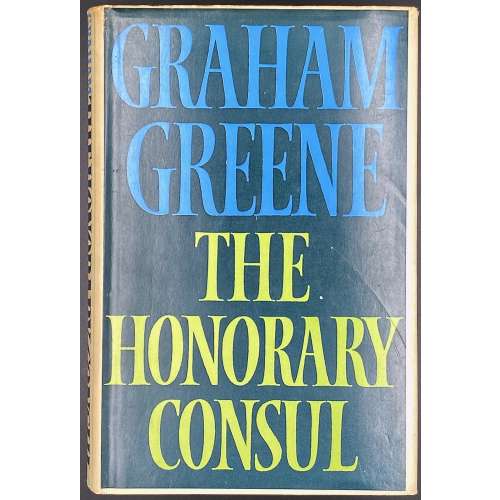 Hardcover, 20.2 x 13.6 cm, green cloth, gilt lettering to spine, in unclipped dust jacket, pp.: [1-8] 9-334 [2]. Title-page: THE HONORARY CONSUL | GRAHAM GREENE | {4 line citation} | {publisher’s device} | THE BODLEY HEAD | LONDON SYDNEY | TORONTO || © Graham Greene 1973. Printed by: William Clowes & Sons Ltd. (Beccles). Graham Greene (British, 1904 – 1991).
Hardcover, 20.2 x 13.6 cm, green cloth, gilt lettering to spine, in unclipped dust jacket, pp.: [1-8] 9-334 [2]. Title-page: THE HONORARY CONSUL | GRAHAM GREENE | {4 line citation} | {publisher’s device} | THE BODLEY HEAD | LONDON SYDNEY | TORONTO || © Graham Greene 1973. Printed by: William Clowes & Sons Ltd. (Beccles). Graham Greene (British, 1904 – 1991). -
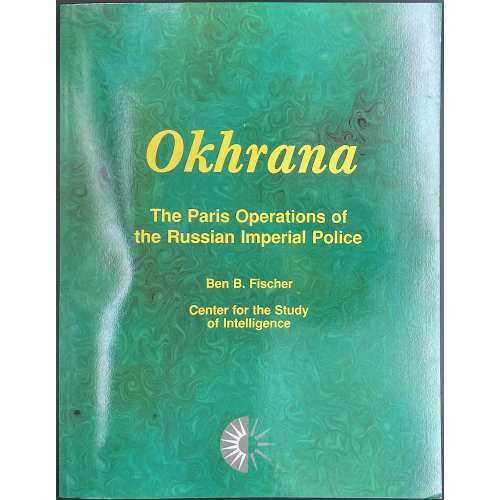 Paperback reprint on demand, 28 x 22 cm, in green malachite wrappers with yellow lettering to both covers; pp. [i-ii] iii-v[vi] 1-122 [4]. Title-page: Okhrana | The Paris Operations of | the Russian Imperial Police | Ben B. Fischer | History Staff | Center for the Study | of Intelligence | Central Intelligence Agency | 1997 || ISBN-10: 1907521992 Benjamin B. Fischer Contents. Foreword. Preface. Okhrana: The Paris Operations of the Russian Imperial Police. From Paris to Palo Alto. CIA Interest in the Okhrana Files. Origins of the Okhrana and Its Paris Office. Foreign Operations. Change and Continuity Dramatis Personae Conclusions Rita T. Kronenbitter Paris Okhrana 1885-1905. The Illustrious Career of Arkadiy Harting. The Sherlock Holmes of the Revolution. Okhrana Agent Dolin. The Okhrana's Female Agents: Part I: Russian Women. The Okhrana's Female Agents: Part II: Indigenous Recruits. Review of Edward Ellis Smith, The Young Stalin, by Harry Gelman. Commentary by Rita T. Kronenbitter.
Paperback reprint on demand, 28 x 22 cm, in green malachite wrappers with yellow lettering to both covers; pp. [i-ii] iii-v[vi] 1-122 [4]. Title-page: Okhrana | The Paris Operations of | the Russian Imperial Police | Ben B. Fischer | History Staff | Center for the Study | of Intelligence | Central Intelligence Agency | 1997 || ISBN-10: 1907521992 Benjamin B. Fischer Contents. Foreword. Preface. Okhrana: The Paris Operations of the Russian Imperial Police. From Paris to Palo Alto. CIA Interest in the Okhrana Files. Origins of the Okhrana and Its Paris Office. Foreign Operations. Change and Continuity Dramatis Personae Conclusions Rita T. Kronenbitter Paris Okhrana 1885-1905. The Illustrious Career of Arkadiy Harting. The Sherlock Holmes of the Revolution. Okhrana Agent Dolin. The Okhrana's Female Agents: Part I: Russian Women. The Okhrana's Female Agents: Part II: Indigenous Recruits. Review of Edward Ellis Smith, The Young Stalin, by Harry Gelman. Commentary by Rita T. Kronenbitter. -
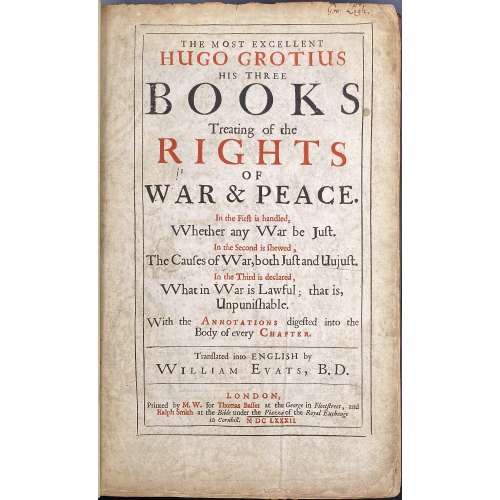 Volume collated 4to, 32.5 x 21 cm, later full calf, blind-tooled boards, sunned, raised bands and gilt lettering to spine. bound without the additional engraved title-page sometimes present; title printed in black and red, woodcut headpieces and initials; a little foxing (mostly marginal) throughout, title lightly dust stained with slight chipping at extremities, minor marginal worming to early leaves (b3-I4), paper flaw to outer margin of E1; contemporary English ownership inscription of George Legh to the title, a handful of manuscript corrections to text and annotations to index. Title-page (double frame, red and black, tall ‘s’): THE MOST EXCELLENT | HUGO GROTIUS | HIS THREE | BOOKS | Treating of the | RIGHTS | OF | WAR & PEACE. | In the First is handled, | Whether any War be Just. | In the Second is shewed , | The Causes of War, both Just and Uujust (sic). | In the Third is declared , | What in War is Lawful ; that is, | Unpunishable. | With the Annotations digested into the | Body of every Chapter. | — | Translated into ENGLISH by | William Evats, B. D. | — | LONDON, | Printed by M. W. for Thomas Basset at the George in Fleetstreet, and | Ralph Smith at the Bible under the Piazza of the Royal Exchange | in Cornhill. M DC LXXXII. || Collation: A4 a-b4 c3 B-Z4 2A-2D4 2E6 3A-3Z4 4A-4D4 4E-4L2; total 247 leaves as called for; lacking engraved title-page. Pagination: [4] i-xxi [5] 1-220 (text continuous) 361-572 [573] [574 blank] [30 table]; total 494 pages. Seller’s note: First edition of the first complete English translation, following Barksdale’s abridgement, of Grotius’s landmark work of political philosophy, the first treatise on international law. First published in Latin in 1625, Grotius’s De iure belli ac pacis “became the basic manual for both the theoretical justification and the entire practice of the international law of war as well as of international law in general for the whole period of the ancien régime in Europe” [Duchhardt, p. 288]. “It would be hard to imagine any work more central to the intellectual world of the Enlightenment … [By] the time of the post-First World War settlement, Grotius was regarded almost exclusively as the founder of modern civilized interstate relations, and as a suitable tutelary presence for the new Peace Palace at The Hague … [In] some ways that was to radically misunderstand Grotius’s views on war; he was in fact much more of an apologist for aggression and violence than many of his more genuinely innovative qualities of his moral theory, qualities that entitle him to an essential place in the history of political theory …” [Tuck, pp. xi-xii]. Contributors: Hugo Grotius (Dutch, 1583 – 1645) – author. William Evats (British, c.1606 – 1677) – translator. Margaret White (British, fl. 1678 – 1683) – printer. Thomas Bassett (British, fl. c. 1659 – 1693) – publisher/bookseller. Ralph Smith (British, fl. 1642 – 1684) – publisher/bookseller.
Volume collated 4to, 32.5 x 21 cm, later full calf, blind-tooled boards, sunned, raised bands and gilt lettering to spine. bound without the additional engraved title-page sometimes present; title printed in black and red, woodcut headpieces and initials; a little foxing (mostly marginal) throughout, title lightly dust stained with slight chipping at extremities, minor marginal worming to early leaves (b3-I4), paper flaw to outer margin of E1; contemporary English ownership inscription of George Legh to the title, a handful of manuscript corrections to text and annotations to index. Title-page (double frame, red and black, tall ‘s’): THE MOST EXCELLENT | HUGO GROTIUS | HIS THREE | BOOKS | Treating of the | RIGHTS | OF | WAR & PEACE. | In the First is handled, | Whether any War be Just. | In the Second is shewed , | The Causes of War, both Just and Uujust (sic). | In the Third is declared , | What in War is Lawful ; that is, | Unpunishable. | With the Annotations digested into the | Body of every Chapter. | — | Translated into ENGLISH by | William Evats, B. D. | — | LONDON, | Printed by M. W. for Thomas Basset at the George in Fleetstreet, and | Ralph Smith at the Bible under the Piazza of the Royal Exchange | in Cornhill. M DC LXXXII. || Collation: A4 a-b4 c3 B-Z4 2A-2D4 2E6 3A-3Z4 4A-4D4 4E-4L2; total 247 leaves as called for; lacking engraved title-page. Pagination: [4] i-xxi [5] 1-220 (text continuous) 361-572 [573] [574 blank] [30 table]; total 494 pages. Seller’s note: First edition of the first complete English translation, following Barksdale’s abridgement, of Grotius’s landmark work of political philosophy, the first treatise on international law. First published in Latin in 1625, Grotius’s De iure belli ac pacis “became the basic manual for both the theoretical justification and the entire practice of the international law of war as well as of international law in general for the whole period of the ancien régime in Europe” [Duchhardt, p. 288]. “It would be hard to imagine any work more central to the intellectual world of the Enlightenment … [By] the time of the post-First World War settlement, Grotius was regarded almost exclusively as the founder of modern civilized interstate relations, and as a suitable tutelary presence for the new Peace Palace at The Hague … [In] some ways that was to radically misunderstand Grotius’s views on war; he was in fact much more of an apologist for aggression and violence than many of his more genuinely innovative qualities of his moral theory, qualities that entitle him to an essential place in the history of political theory …” [Tuck, pp. xi-xii]. Contributors: Hugo Grotius (Dutch, 1583 – 1645) – author. William Evats (British, c.1606 – 1677) – translator. Margaret White (British, fl. 1678 – 1683) – printer. Thomas Bassett (British, fl. c. 1659 – 1693) – publisher/bookseller. Ralph Smith (British, fl. 1642 – 1684) – publisher/bookseller. -
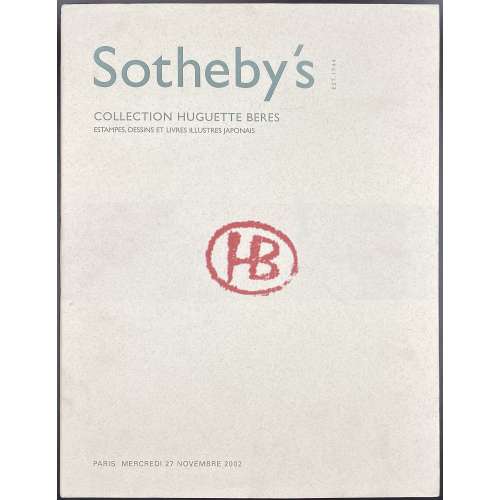 Two paperback volumes, 29.6 x 22.8 cm, pictorial softcover in full dust jacket with letering (see below); One the back DJ of both volumes lettered: “Sotheby’s | EST. 1744 (vertical) | GALERIE CHARPENTIER 76 RUE DE FAUBOURG SAINT-HONORÉ 75008 PARIS WWW. SOTHEBYS.COM”. Vol. 1: DJ lettered in olive green: Sotheby’s | EST. 1744 (vertical) | COLLECTION HUGUETTE BERES | ESTAMPES, DESSINS ET LIVRES ILLUSTRES JAPONAIS | {HB monogram in red} | PARIS MERCREDI 27 NOVEMBRE 2002 ||. Pagination: 2 ffl, [1-5] (h.t., t.p., Sommaire), 6-340, 2 ffl; 229 lots with ils.; sale PF2021 Vol. 2: DJ lettered in olive green: “Sotheby’s | EST. 1744 (vertical) | COLLECTION HUGUETTE BERES | ESTAMPES, DESSINS ET LIVRES ILLUSTRES JAPONAIS (SECONDE VENTE) | {HB monogram in red} | PARIS MARDI 25 novembre 2003 ||. Pagination: 2 ffl, [1-7] (h.t., t.p., Sommaire, f.t.) 8-287 [288 blank], 2 ffl; 252 lots with ils.; sale PF3018. Contributors: Huguette Berès (French, 1913 – 1999)
Two paperback volumes, 29.6 x 22.8 cm, pictorial softcover in full dust jacket with letering (see below); One the back DJ of both volumes lettered: “Sotheby’s | EST. 1744 (vertical) | GALERIE CHARPENTIER 76 RUE DE FAUBOURG SAINT-HONORÉ 75008 PARIS WWW. SOTHEBYS.COM”. Vol. 1: DJ lettered in olive green: Sotheby’s | EST. 1744 (vertical) | COLLECTION HUGUETTE BERES | ESTAMPES, DESSINS ET LIVRES ILLUSTRES JAPONAIS | {HB monogram in red} | PARIS MERCREDI 27 NOVEMBRE 2002 ||. Pagination: 2 ffl, [1-5] (h.t., t.p., Sommaire), 6-340, 2 ffl; 229 lots with ils.; sale PF2021 Vol. 2: DJ lettered in olive green: “Sotheby’s | EST. 1744 (vertical) | COLLECTION HUGUETTE BERES | ESTAMPES, DESSINS ET LIVRES ILLUSTRES JAPONAIS (SECONDE VENTE) | {HB monogram in red} | PARIS MARDI 25 novembre 2003 ||. Pagination: 2 ffl, [1-7] (h.t., t.p., Sommaire, f.t.) 8-287 [288 blank], 2 ffl; 252 lots with ils.; sale PF3018. Contributors: Huguette Berès (French, 1913 – 1999) -
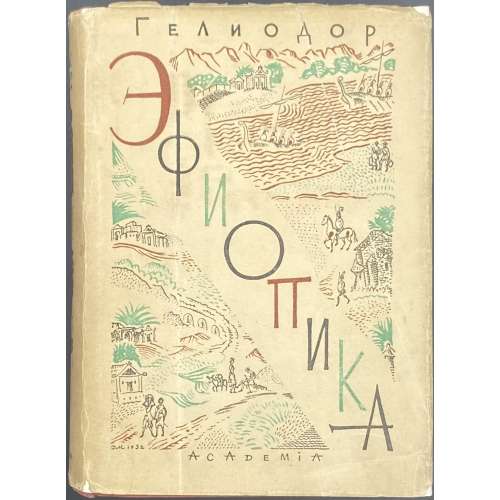 Hardcover volume, 18 x 13 cm, bound in purple cloth with stamped design to boards and spine, lettering to spine, pictorial dust jacket, pictorial endpapers, pp.: [1-9] 10-491 [5], collated in 8vo: [1]-[31]8, 248 leaves (496 pages); covers, endpapers, DJ, head- and tailpieces, vignettes on the frontispiece, title-page, and faux-titles after Dmitry Mitrohin; text in Russian. Frontispiece (black and grey): СОКРОВИЩА | МИРОВОЙ | ЛИТЕРАТУРЫ | ГЕЛИОДОР | ЭФИОПИКА | {vignette} | ACADEMIA | МОСКВА ЛЕНИНГРАД | 1932 || Title-page: ГЕЛИОДОР | ЭФИОПИКА | ВСТУПИТЕЛЬНАЯ | СТАТЬЯ | РЕДАКЦИЯ | ПЕРЕВОДА | И | ПРИМЕЧАНИЯ | А. ЕГУНОВА | {vignette} | ACADEMIA | МОСКВА ЛЕНИНГРАД | 1932 || Title verso: ΗΛΙΟΔΩΡΟΥ | ΑΙΘΙΟΠΙΚΩΝ | ΒΙΒΛΙΑ | ΔΕΚΑ | Орнаментация книги | Д. И. Митрохина || Contributors: Heliodorus Emesenus [Ηλιόδωρος ο Εμεσηνός] (Greek, 3-4 century AD) – author. Андрей Николаевич Егунов (Russian, 1895 – 1968) – editor, author. Дмитрий Исидорович Митрохин [Dmitry Mitrohin] (Russian, 1883 – 1973) – artist. For French translation, see LIB-3027.2022.
Hardcover volume, 18 x 13 cm, bound in purple cloth with stamped design to boards and spine, lettering to spine, pictorial dust jacket, pictorial endpapers, pp.: [1-9] 10-491 [5], collated in 8vo: [1]-[31]8, 248 leaves (496 pages); covers, endpapers, DJ, head- and tailpieces, vignettes on the frontispiece, title-page, and faux-titles after Dmitry Mitrohin; text in Russian. Frontispiece (black and grey): СОКРОВИЩА | МИРОВОЙ | ЛИТЕРАТУРЫ | ГЕЛИОДОР | ЭФИОПИКА | {vignette} | ACADEMIA | МОСКВА ЛЕНИНГРАД | 1932 || Title-page: ГЕЛИОДОР | ЭФИОПИКА | ВСТУПИТЕЛЬНАЯ | СТАТЬЯ | РЕДАКЦИЯ | ПЕРЕВОДА | И | ПРИМЕЧАНИЯ | А. ЕГУНОВА | {vignette} | ACADEMIA | МОСКВА ЛЕНИНГРАД | 1932 || Title verso: ΗΛΙΟΔΩΡΟΥ | ΑΙΘΙΟΠΙΚΩΝ | ΒΙΒΛΙΑ | ΔΕΚΑ | Орнаментация книги | Д. И. Митрохина || Contributors: Heliodorus Emesenus [Ηλιόδωρος ο Εμεσηνός] (Greek, 3-4 century AD) – author. Андрей Николаевич Егунов (Russian, 1895 – 1968) – editor, author. Дмитрий Исидорович Митрохин [Dmitry Mitrohin] (Russian, 1883 – 1973) – artist. For French translation, see LIB-3027.2022. -
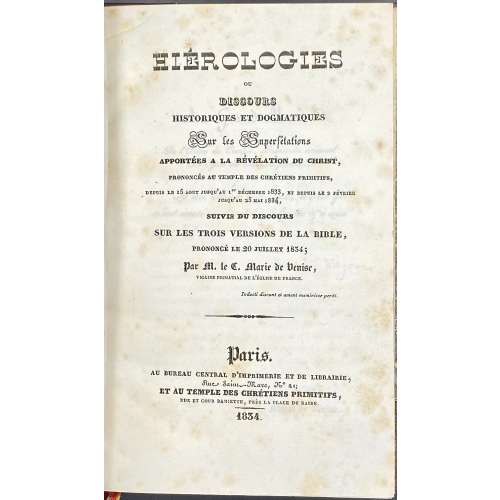 Hardcover volume, 20.7 x 13.5 cm, modern half morocco over marbled boards, gilt lettering and ornament to spine, pp.: [i-vii] viii-xvi [17] 18-255 [256], collated 8vo: 1-168, 128 leaves. Title-page: HIÉROLOGIES | OU | DISCOURS | HISTORIQUES ET DOGMATIQUES | Sur les Superfétations | APPORTÉES A LA RÉVÉLATION DU CHRIST, | PRONONCÉS AU TEMPLE DES CHRÉTIENS PRIMITIFS, | DEPUIS LE 15 AOUT JUSQU’AU 1er DÉCEMBRE 1833, ET DEPUIS LE 2 FÉVRIER | JUSQU’AU 25 MAI 1834, | SUIVIS DU DISCOURS | SUR LES TROIS VERSIONS DE LA BIBLE, | PRONONCÉ LE 20 JUILLET 1834 ; | Par M. le C. Marie de Venise, | VICAIRE PRIMATIAL DE L’EGLISE DE France. | {1 line citation} | — | Paris. | AU BUREAU CENTRAL D’IMPRIMERIE ET DE LIBRAIRE, | Rue Saint-Marc, No 21; | ET AU TEMPLE DES CHRÉTIENS PRIMITIFS, | RUE ET COUR DAMIETTE, PRÈS LA PLACE DU KAIRE. | — | 1834 || Contributors : Félix Ragon (French, 1795 – 1872) – author. Seller's description: [RAGON (Félix) : Hiérologies ou Discours historiques et dogmatiques sur les Superfétations apportées à la révélation du Christ suivis du Discours sur les trois versions de la Bible. Paris, au Bureau central et au Temple des Chrétiens Primitifs, 1834 ; in 8°, demi-basane brune à coins. Reliure pastiche moderne. Edition originale extrêmement rare, dont le tirage est estimé à 50 ex.
Hardcover volume, 20.7 x 13.5 cm, modern half morocco over marbled boards, gilt lettering and ornament to spine, pp.: [i-vii] viii-xvi [17] 18-255 [256], collated 8vo: 1-168, 128 leaves. Title-page: HIÉROLOGIES | OU | DISCOURS | HISTORIQUES ET DOGMATIQUES | Sur les Superfétations | APPORTÉES A LA RÉVÉLATION DU CHRIST, | PRONONCÉS AU TEMPLE DES CHRÉTIENS PRIMITIFS, | DEPUIS LE 15 AOUT JUSQU’AU 1er DÉCEMBRE 1833, ET DEPUIS LE 2 FÉVRIER | JUSQU’AU 25 MAI 1834, | SUIVIS DU DISCOURS | SUR LES TROIS VERSIONS DE LA BIBLE, | PRONONCÉ LE 20 JUILLET 1834 ; | Par M. le C. Marie de Venise, | VICAIRE PRIMATIAL DE L’EGLISE DE France. | {1 line citation} | — | Paris. | AU BUREAU CENTRAL D’IMPRIMERIE ET DE LIBRAIRE, | Rue Saint-Marc, No 21; | ET AU TEMPLE DES CHRÉTIENS PRIMITIFS, | RUE ET COUR DAMIETTE, PRÈS LA PLACE DU KAIRE. | — | 1834 || Contributors : Félix Ragon (French, 1795 – 1872) – author. Seller's description: [RAGON (Félix) : Hiérologies ou Discours historiques et dogmatiques sur les Superfétations apportées à la révélation du Christ suivis du Discours sur les trois versions de la Bible. Paris, au Bureau central et au Temple des Chrétiens Primitifs, 1834 ; in 8°, demi-basane brune à coins. Reliure pastiche moderne. Edition originale extrêmement rare, dont le tirage est estimé à 50 ex. -
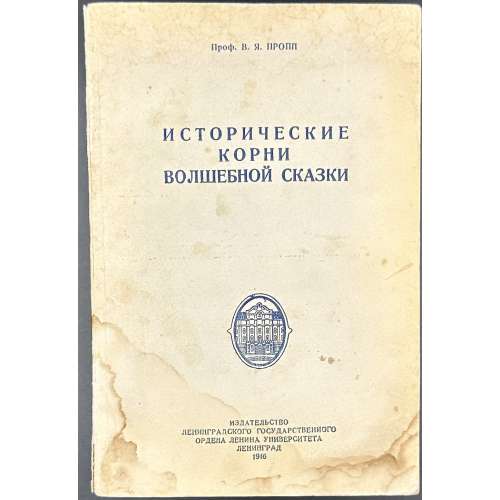 Paperback, 21.3 x 14.4 cm, 8vo, in original wrappers, lettered to front and spine, printed on brownish paper, previous owner's blue crayon manuscript, water stain to the outside, collated [1] 2-208 2110 (total 340 pp.); pp: [1-5] 6-340. Title-page: Пооф. В. Я. ПРОПП | ИСТОРИЧЕСКИЕ | КОРНИ | ВОЛШЕБНОЙ СКАЗКИ | ИЗДАТЕЛЬСТВО | ЛЕНИНГРАДСКОГО ГОСУДАРСТВЕННОГО | ОРДЕНА ЛЕНИНА УНИВЕРСИТЕТА | ЛЕНИНГРАД | 1946 || Print run: 10,000 copies. Contributors: Владимир Яковлевич Пропп [Vladimir Propp] (Russian, 1895 – 1970) For the circulation copy see [LIB-1710.2019] В. Я. Пропп. Исторические корни волшебной сказки (2-е изд.) — Л.: Изд-во ЛГУ, 1986. English title: [LIB-1615.2018] V. Propp. Morphology of the Folktale. — Austin: University of Texas Press, 1979.
Paperback, 21.3 x 14.4 cm, 8vo, in original wrappers, lettered to front and spine, printed on brownish paper, previous owner's blue crayon manuscript, water stain to the outside, collated [1] 2-208 2110 (total 340 pp.); pp: [1-5] 6-340. Title-page: Пооф. В. Я. ПРОПП | ИСТОРИЧЕСКИЕ | КОРНИ | ВОЛШЕБНОЙ СКАЗКИ | ИЗДАТЕЛЬСТВО | ЛЕНИНГРАДСКОГО ГОСУДАРСТВЕННОГО | ОРДЕНА ЛЕНИНА УНИВЕРСИТЕТА | ЛЕНИНГРАД | 1946 || Print run: 10,000 copies. Contributors: Владимир Яковлевич Пропп [Vladimir Propp] (Russian, 1895 – 1970) For the circulation copy see [LIB-1710.2019] В. Я. Пропп. Исторические корни волшебной сказки (2-е изд.) — Л.: Изд-во ЛГУ, 1986. English title: [LIB-1615.2018] V. Propp. Morphology of the Folktale. — Austin: University of Texas Press, 1979. -
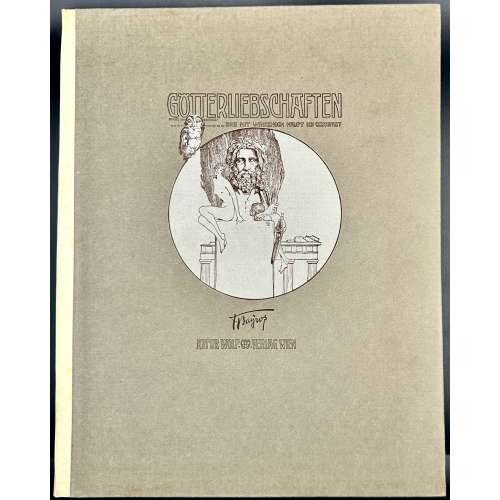 Letterpress title-page, engraved title-page, and 10 sheets of collotype plates printed on india paper mounted on thick wove paper, with captioned guard sheets, loose in a vellum-backed cardboard portfolio with cloth-mounted flaps; floral diaper design inside throughout; bookseller's label to front board verso; limited edition of 550 copies of which this is copy № 103. Dimensions: 338 x 268 mm portfolio; 325 x 260 mm sheet, 225 x 195 mm image. Front board with lettering and vignette: GÖTTERLIEBSCHAFTEN | DAS MIT WINKENDEM HAUPT ICH GEWAHRET | {vignette} | {signature} | ARTUR WOLF / VERLAG WIEN || Letterpress title-page: FRANZ VON BAYROS | “GÖTTERLIEBSCHAFTEN” | ARTUR WOLF / VERLAG WIEN | 1914 || Verso to letterpress t.p. VERZEICHNIS DER TAFELN.
Letterpress title-page, engraved title-page, and 10 sheets of collotype plates printed on india paper mounted on thick wove paper, with captioned guard sheets, loose in a vellum-backed cardboard portfolio with cloth-mounted flaps; floral diaper design inside throughout; bookseller's label to front board verso; limited edition of 550 copies of which this is copy № 103. Dimensions: 338 x 268 mm portfolio; 325 x 260 mm sheet, 225 x 195 mm image. Front board with lettering and vignette: GÖTTERLIEBSCHAFTEN | DAS MIT WINKENDEM HAUPT ICH GEWAHRET | {vignette} | {signature} | ARTUR WOLF / VERLAG WIEN || Letterpress title-page: FRANZ VON BAYROS | “GÖTTERLIEBSCHAFTEN” | ARTUR WOLF / VERLAG WIEN | 1914 || Verso to letterpress t.p. VERZEICHNIS DER TAFELN.- Europa und der Stier
- Leda und die Schildkröte
- Sterope und Herkules
- Herodikos und die Turnerinnen
- Phoroneus und die Hirtin
- Minos und Persipeia
- Phryne und Mutter
- Pytalos und Demeter
- Kirke und die Ferkel
- Putiphar
-
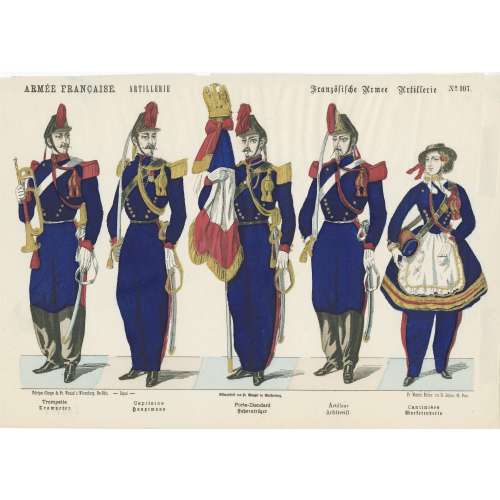 Hand-coloured woodcut on wove paper, 265 x 378 mm; black ink stamp “5051 1” to reverse. Top left: "ARMÉE FRANCAISE. ARTILLERIE"; right: (gothic font) "Französische Armee Artillerie" — "№ 107". Below left: "Fabrique d’Images de Fr. Wentzel à Wissembeurg. Bas-Rhin." — "Déposé" —, centre: "Bilderfabrit von Fr. Wentzel in Weissenburg", right: "Fr. Wentzel, Éditeur, rue St. Jacques, 65, Paris". Bottom: "Trompette | Trompeter" — "Capitaine | Gauptmann" — "Porte-Étendard | Fahnenträger" — "Artilleur | Artillerist" — "Cantinière | Marketenderin". Jean Frédéric Wentzel (French, 1807 – 1869) – publisher/printer.
Hand-coloured woodcut on wove paper, 265 x 378 mm; black ink stamp “5051 1” to reverse. Top left: "ARMÉE FRANCAISE. ARTILLERIE"; right: (gothic font) "Französische Armee Artillerie" — "№ 107". Below left: "Fabrique d’Images de Fr. Wentzel à Wissembeurg. Bas-Rhin." — "Déposé" —, centre: "Bilderfabrit von Fr. Wentzel in Weissenburg", right: "Fr. Wentzel, Éditeur, rue St. Jacques, 65, Paris". Bottom: "Trompette | Trompeter" — "Capitaine | Gauptmann" — "Porte-Étendard | Fahnenträger" — "Artilleur | Artillerist" — "Cantinière | Marketenderin". Jean Frédéric Wentzel (French, 1807 – 1869) – publisher/printer. -
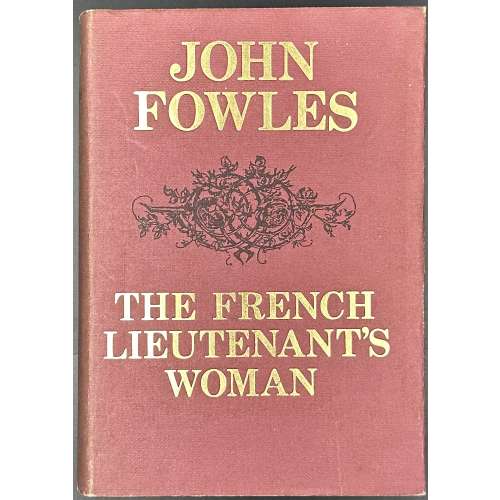 Hardcover volume, 20.2 x 14.5 cm, aubergine cloth, gilt lettering and publisher’s device to spine, aubergine top edge, aubergine dust jacket with gilt lettering and black fleuron to front, gilt lettering and black fleuron and publisher’s device to spine, and a captioned photographic portrait to back, blurb text to flaps, price ”35s net | in U.K. only” unclipped; pictorial endpapers. Pp.: [1-8] 9-445 [446] [2], collation: A-O16, total 224 leaves. Title-page (in oval frame): JOHN FOWLES | THE | FRENCH | LIEUTENANT'S | WOMAN | — | Every emancipation is a restoration of the human | world and of human relationships to man himself. | MARX, Zur Judenfrage (1844) | JONATHAN CAPE | THIRTY BEDFORD SQUARE | LONDON || Contributors: John Fowles (British, 1926 – 2005) – author. Herbert Jonathan Cape (British, 1879 – 1960) – publisher. Ebenezer Baylis & Son, Ltd. (f. 1858) – printer. The Trinity Press – printer.
Hardcover volume, 20.2 x 14.5 cm, aubergine cloth, gilt lettering and publisher’s device to spine, aubergine top edge, aubergine dust jacket with gilt lettering and black fleuron to front, gilt lettering and black fleuron and publisher’s device to spine, and a captioned photographic portrait to back, blurb text to flaps, price ”35s net | in U.K. only” unclipped; pictorial endpapers. Pp.: [1-8] 9-445 [446] [2], collation: A-O16, total 224 leaves. Title-page (in oval frame): JOHN FOWLES | THE | FRENCH | LIEUTENANT'S | WOMAN | — | Every emancipation is a restoration of the human | world and of human relationships to man himself. | MARX, Zur Judenfrage (1844) | JONATHAN CAPE | THIRTY BEDFORD SQUARE | LONDON || Contributors: John Fowles (British, 1926 – 2005) – author. Herbert Jonathan Cape (British, 1879 – 1960) – publisher. Ebenezer Baylis & Son, Ltd. (f. 1858) – printer. The Trinity Press – printer. -
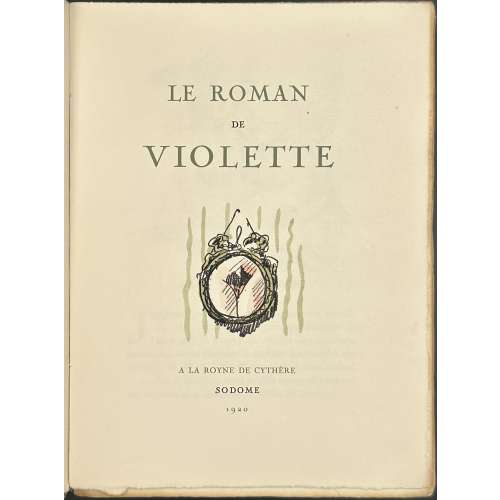 Softcover volume, 19.5 x 14.3 cm, olive French flapped wrappers, glassine dust cover, printed on laid paper (Hollande), outer and bottom margins untrimmed, some pages uncut; pagination: [2] blank, [i-iv] h.t./limit., t.p./blank, v-viii, 1-196 [197] [5], total 212 pages plus frontispiece; head- and tailpieces and in-text stencil-coloured etchings after Chéripoulos. Title-page (olive and black): LE ROMAN | DE | VIOLETTE | {vignette} | A LA ROYNE DE CYTHÈRE | SODOME | 1920 || Limitation: Cet ouvrage, achevé d'imprimer le cinq Janvier Mil Neuf Cent Vingt à trois cents exemplaires dont vingt-cinq exemplaires sur Japon Impérial contenant chacun un dessin original de Chéripoulos, numérotés de un à vingt-cinq; deux cent soixante-quinze exemplaires sur papier de Hollande, numérotés de vingt-six à trois cents; en plus cinq exemplaires de collaborateurs marqués de A à E. Le présent exemplaire porte le numéro 72. Edition: Printed on the 5th of January 1920 in 305 copies (№№ 1-25 on Japon Impérial, №№ 26-300 on Hollande, A–E for collaborators). Catalogue raisonné: Dutel III № 2339, p. 350. Contributors: Henriette de Mannoury d'Ectot [Henriette Nicolas Le Blanc] (French 1815 – 1899) Charles Auguste Edelmann [Chéripoulos] (French, 1879 – 1950).
Softcover volume, 19.5 x 14.3 cm, olive French flapped wrappers, glassine dust cover, printed on laid paper (Hollande), outer and bottom margins untrimmed, some pages uncut; pagination: [2] blank, [i-iv] h.t./limit., t.p./blank, v-viii, 1-196 [197] [5], total 212 pages plus frontispiece; head- and tailpieces and in-text stencil-coloured etchings after Chéripoulos. Title-page (olive and black): LE ROMAN | DE | VIOLETTE | {vignette} | A LA ROYNE DE CYTHÈRE | SODOME | 1920 || Limitation: Cet ouvrage, achevé d'imprimer le cinq Janvier Mil Neuf Cent Vingt à trois cents exemplaires dont vingt-cinq exemplaires sur Japon Impérial contenant chacun un dessin original de Chéripoulos, numérotés de un à vingt-cinq; deux cent soixante-quinze exemplaires sur papier de Hollande, numérotés de vingt-six à trois cents; en plus cinq exemplaires de collaborateurs marqués de A à E. Le présent exemplaire porte le numéro 72. Edition: Printed on the 5th of January 1920 in 305 copies (№№ 1-25 on Japon Impérial, №№ 26-300 on Hollande, A–E for collaborators). Catalogue raisonné: Dutel III № 2339, p. 350. Contributors: Henriette de Mannoury d'Ectot [Henriette Nicolas Le Blanc] (French 1815 – 1899) Charles Auguste Edelmann [Chéripoulos] (French, 1879 – 1950). -

Б. Л. Модзалевский. Библиотека А.С.Пушкина. Библиографическое описание. Отдѣльный оттискъ из изданiя "Пушкинъ и его современники", вып. IX-X. -- СПб.: Тип. Императорской Академiи Наук, 1910. - 442 стр. [РЕПРИНТ 1988 года.]
Библиотека А. С. Пушкина. Б. Л. Модзалевский. Приложение к репринтному изданию. -- М.: Книга, 1988. - 115 стр. Тираж 10 000 экз.
Л. Б. Модзалевский. Библиотека Пушкина. Новые материалы.
Список условных сокращений.
Л. С. Сидяков. Библиотека Пушкина и ее описание.
Примечание к работам Б. Л. и Л. Б. Модзалевских.
-
 Fuchi-kashira of copper, carved and inlaid with gold and shakudō, with the design of Kanzan (on kashira), Chinese: Hanshan, an eccentric poet of the Tang dynasty with a scroll (618-906) who befriended Jittoku (on fuchi, Chinese: Shide, a kitchen helper at a mountain temple, holding a broom). Fuchi is signed Josui (如⽔). Fuchi (Jittoku, holding a broom): 38 x 22 x 12 mm. Weight: 23g (Nakago hole: 27 x 8.5 mm); Kashira (Kanzan, reading a scroll): 34 x 17 x 9 mm. Weight: 10g. Materials: Copper, gold, shakudō. Techniques: Tsuchi-me-ji (hammer-marked surface); usu-shishiai-bori or usuniku-bori (low-relief carving which leaves the image somewhat higher than the surface - high relief effect); zōgan (inlay). Josui was a daughter of Jochiku Kamo (Markus Sesko, Genealogies).
Fuchi-kashira of copper, carved and inlaid with gold and shakudō, with the design of Kanzan (on kashira), Chinese: Hanshan, an eccentric poet of the Tang dynasty with a scroll (618-906) who befriended Jittoku (on fuchi, Chinese: Shide, a kitchen helper at a mountain temple, holding a broom). Fuchi is signed Josui (如⽔). Fuchi (Jittoku, holding a broom): 38 x 22 x 12 mm. Weight: 23g (Nakago hole: 27 x 8.5 mm); Kashira (Kanzan, reading a scroll): 34 x 17 x 9 mm. Weight: 10g. Materials: Copper, gold, shakudō. Techniques: Tsuchi-me-ji (hammer-marked surface); usu-shishiai-bori or usuniku-bori (low-relief carving which leaves the image somewhat higher than the surface - high relief effect); zōgan (inlay). Josui was a daughter of Jochiku Kamo (Markus Sesko, Genealogies). -
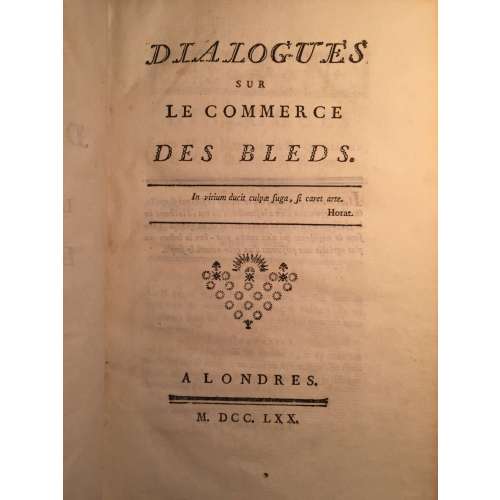
GALIANI, Ferdinando, Abbé. Dialogue sur le commerce des bleds. Londres, 1770. L'Abbé Roubaud, Pierre Joseph André. Récréations économiques ou lettres de l'auteur des représentations aux magistrats, a M. le chevalier Zanobi, principal interlocuteur des Dialogues sur le commerce des bleds; Amsterdam & Paris, Delalain, 1770. Béguillet, Edme. De principiis vegetationis et agreculturae et de causis triplicis culturae in Burgundia disquisitio physica. Auctore E.B.D. ex Societate Œconomica Lugdunensi; Divione, 1768.
-
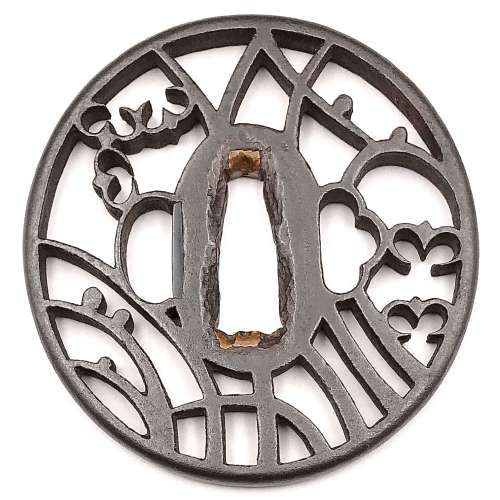 Iron tsuba of slightly elongated round form with design of wild geese and drops on pampas grass (masashino) in openwork (sukashi). Rounded rim. Copper sekigane. Owari school. Early Edo period: early 17th century (Kan-ei era). Height: 78.8 mm. Width: 76.3 mm. Rim thickness: 6.1 mm. Center thickness: 6.4 mm. Provenance: Sasano Masayuki Collection, № 169. A description of musashino symbolism can be found at Symbols of Japan by Merrily Baird [Merrily Baird. Symbols of Japan. Thematic motifs in art and design. Rizzoli international publications, Inc., 2001]: Musashino - "the plain of Musashi - a large expanse in the Tokyo area, was celebrated in poetry for the grasses that grew there before the recent era of industrialization... The use of Musashino themes was particularly common in the Momoyama and Edo periods". Pampas grass with dew drops and wild geese in flight collectively provide strong autumnal connotation.
Iron tsuba of slightly elongated round form with design of wild geese and drops on pampas grass (masashino) in openwork (sukashi). Rounded rim. Copper sekigane. Owari school. Early Edo period: early 17th century (Kan-ei era). Height: 78.8 mm. Width: 76.3 mm. Rim thickness: 6.1 mm. Center thickness: 6.4 mm. Provenance: Sasano Masayuki Collection, № 169. A description of musashino symbolism can be found at Symbols of Japan by Merrily Baird [Merrily Baird. Symbols of Japan. Thematic motifs in art and design. Rizzoli international publications, Inc., 2001]: Musashino - "the plain of Musashi - a large expanse in the Tokyo area, was celebrated in poetry for the grasses that grew there before the recent era of industrialization... The use of Musashino themes was particularly common in the Momoyama and Edo periods". Pampas grass with dew drops and wild geese in flight collectively provide strong autumnal connotation. -
 Iron tsuba of round form with two ebi (lobster) on omote (obverse side) and shika (deer) among scattered momiji (maple leaves) on ura (reverse side) motif in brass takabori (high relief) suemon-zōgan. Traces of lacquer. Unsigned. Late Muromachi / Momoyama period (late 16th / Early 17th century). Dimensions: 69.0.6 mm (H) x 69.6 mm (W) x 3.4 mm (T, seppa-dai). Weight: 92.6 g. Illustrated at: The Lundgren Collection of Japanese Swords, Sword Fittings and A Group of Miochin School Metalwork. Christie's Auction: Tuesday, 18 November 1997, London. Sales "GOTO-5881". Christie's, 1997. - #2 at page 7. Provenance: The second John Harding; The Lundgren Collection. Description at Christie's: "The iron plate depicting two lobsters in takabory and brass takazogan, the reverse similarly decorated with deer among scattered maple leaves, square mimi, late Muromachi / early Momoyama period (late 16th/early 17th century) Diameter 68 mm, mimi thickness 4 mm. Provenance: The second John Harding." Also at: JAPANESE SWORD-FITTINGS & METALWORK IN THE LUNDGREN COLLECTION. Published by Otsuka Kogeisha, Tokyo 1992. № 134. Description on page 173: Sword guard with design of shrimps in inlay (scarlet [sic] maple leaves and deer on the reverse side). Unsigned. Heianjō inlay school. Vertical 6.85 cm, horizontal 6.90 cm, Th. of rim 0.40 cm. Iron. Taka-bori relief and brass inlay. Momoyama period, 16th - 17th century. According to Merrily Baird, maple leaves, especially if paired with the deer, allude to autumnal tradition of Japanese aristocracy of viewing the seasonal changes of color in the Nara area. The lobster is typical Japanese ebi, - it lacks prominent claws, and has a spiny shell. As a symbol of longevity and good fortune, lobster is a staple of New Year's decoration.
Iron tsuba of round form with two ebi (lobster) on omote (obverse side) and shika (deer) among scattered momiji (maple leaves) on ura (reverse side) motif in brass takabori (high relief) suemon-zōgan. Traces of lacquer. Unsigned. Late Muromachi / Momoyama period (late 16th / Early 17th century). Dimensions: 69.0.6 mm (H) x 69.6 mm (W) x 3.4 mm (T, seppa-dai). Weight: 92.6 g. Illustrated at: The Lundgren Collection of Japanese Swords, Sword Fittings and A Group of Miochin School Metalwork. Christie's Auction: Tuesday, 18 November 1997, London. Sales "GOTO-5881". Christie's, 1997. - #2 at page 7. Provenance: The second John Harding; The Lundgren Collection. Description at Christie's: "The iron plate depicting two lobsters in takabory and brass takazogan, the reverse similarly decorated with deer among scattered maple leaves, square mimi, late Muromachi / early Momoyama period (late 16th/early 17th century) Diameter 68 mm, mimi thickness 4 mm. Provenance: The second John Harding." Also at: JAPANESE SWORD-FITTINGS & METALWORK IN THE LUNDGREN COLLECTION. Published by Otsuka Kogeisha, Tokyo 1992. № 134. Description on page 173: Sword guard with design of shrimps in inlay (scarlet [sic] maple leaves and deer on the reverse side). Unsigned. Heianjō inlay school. Vertical 6.85 cm, horizontal 6.90 cm, Th. of rim 0.40 cm. Iron. Taka-bori relief and brass inlay. Momoyama period, 16th - 17th century. According to Merrily Baird, maple leaves, especially if paired with the deer, allude to autumnal tradition of Japanese aristocracy of viewing the seasonal changes of color in the Nara area. The lobster is typical Japanese ebi, - it lacks prominent claws, and has a spiny shell. As a symbol of longevity and good fortune, lobster is a staple of New Year's decoration. -
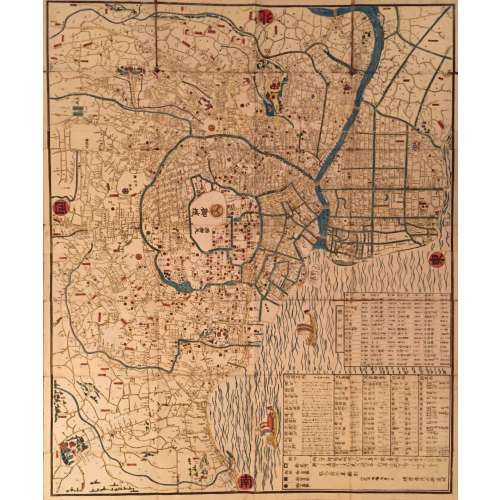
-
 Katsukawa Shun'ei. Signed: Shun'ei ga (春英画). Vertical Ōban. No reference whatsoever. Unidentified play, actors, roles, year, theatre. SOLD
Katsukawa Shun'ei. Signed: Shun'ei ga (春英画). Vertical Ōban. No reference whatsoever. Unidentified play, actors, roles, year, theatre. SOLD


